 |
23 Feb: Marrakesh (II) |
 |
23 Feb: Marrakesh (II) |
Palaces, Gardens and Drugs
Bid farewell to the Canadians who set off for a High Atlas hike.
I went to the Jemaa alone for breakfast - a good bowl of harira (beans/lentils
soup), and then visited the Palais el-Badi, built by the great Saadian
Sultan, Ahmed al-Mansour, conqueror of Timbuktu between 1578 and 1602.
The palace was at its time one of the grandest in the world. Today,
only its enormous but bare walls remain, as it was torn apart by subsequent
dynasties, so that its materials could be used to build a new capital in
Mekes in the north. By just looking at the huge ruins, one could
imagine how grand the palace must had been in those days. Another
interesting sight was the hundreds of storks that have built their nests
on the ancient walls and columns. They were perhaps the liveliest
creatures in the ruins these days. At this point, I should confess
that the naughty Asian in me wondered what barbecued storks would taste
like.
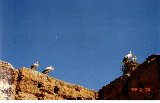 |
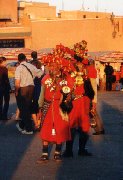 |
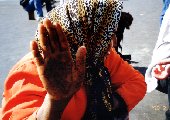 |
|
|
|
|
Wanted to visit Palais de la Bahia, a live-in palace built in the 19th century, part of which is still used by the royal family. Well, the king was in Marrakesh to prepare for his coronation and the palace was thus closed to the public. A pity. I then checked out of Hotel de France and moved into Hotel Ali, so that I could get up early the next day for the expedition.
After a great lunch (topped with a few glasses of orange juices too)
at Jemaa, I set off for Jardin Menara with my Swiss and Spanish friends,
as well as two Brazilians we met today. Took bus 11 to this park
which also happens to be one of the most famous images of Marrakesh - pictures
often show a rectangular pool with a two-storey building on one side and
the snow-capped Atlas Mountains as a backdrop. We arrived to find
that, true, there is the pool and the structure, but wondered where the
garden was, for the pool was in the middle of an olive plantation.
The snow-capped mountains were there, though unfortunately, the sky was
a little misty. It was said that this was indeed once a "real" garden
built by the sultans. The French came, and decided to replace the
garden with something more profitable for the colonial administration,
and so we have the olive trees of today. A pity, but that was compensated
by the cheerfulness of our Brazilian companions, who sang to the tunes
of guitar (carried over thousands of miles by one of them).
We returned to Jemaa. The Swiss chap and I had tea in one expensive
looking café which charged only DH 5 or US$0.70 for tea, while the
rest returned to Hotel de France. We agreed to meet 2 hours later
to have dinner together. After waiting well beyond the agreed time,
the two of us returned to the hotel to look for them. Knocking on
their door, we heard some commotion from within and R., one of the Spaniards,
looked out of the window. He seemed relieved to see us, and opened
the door. And guess what, we found the Spaniards smoking cannabis
inside. I remembered the law of association, mentioned in the guidebooks
- anyone found together with people actually guilty of possessing drugs,
may be deemed to have acting in concert with those found guilty.
I immediately stepped out of the room, and asked the chaps to hurry up
for dinner. Alas, the plague of drugs…
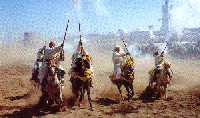 |
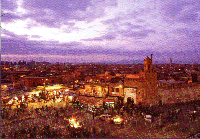 |
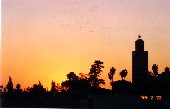 |
|
|
|
|
Dinner at the Jemaa, and again, the Brazilians attracted much local attention by playing the guitar amidst the street hawkers. It was a cloudless night full of stars, and we had a great evening chatting at the Jemaa, while soothing Brazilian sentimentals as well as exuberant Moroccan drum beatings (courtesy of friendly orange sellers) filled the air. It's my last night in Marrakesh. I will miss this city.